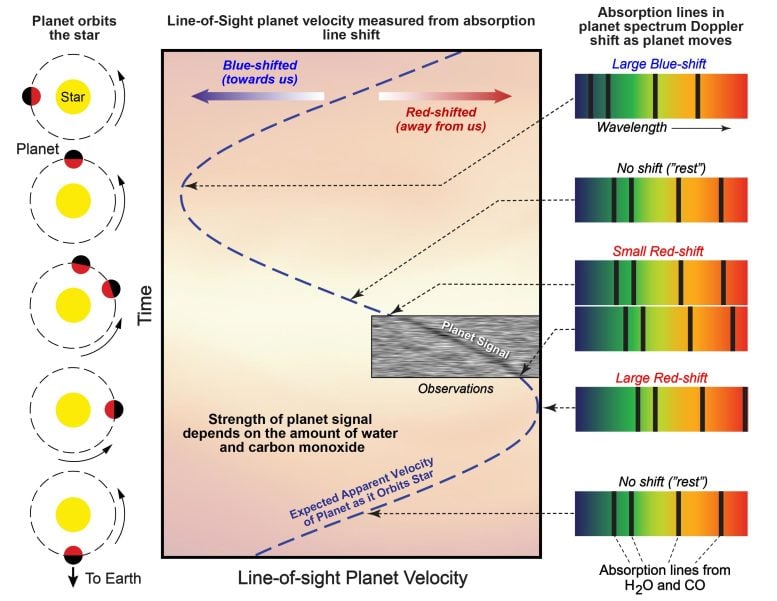An international team of scientists, using the ground-based Gemini Observatory telescope in Chile, is the first to directly measure the amount of both water and carbon monoxide in the atmosphere of a planet in another solar system roughly 340 light-years away.
The team is led by Assistant Professor Michael Line of Arizona State University’s School of Earth and Space Exploration, and the results were published today (October 27, 2021) in the journal Nature.
There are thousands of known planets outside of our own solar system (called exoplanets). Scientists use both space telescopes and ground-based telescopes to examine how these exoplanets form and how they are different from the planets in our own solar system.
For this study, Line and his team focused on planet “WASP-77Ab,” a type of exoplanet called a “hot Jupiter” because they are like our solar system’s Jupiter, but with a temperature upwards of 2,000 degrees Fahrenheit (1,100 degrees Celsius).
They then focused on measuring the composition of its atmosphere to determine what elements are present, compared with the star it orbits.
“Because of their sizes and temperatures, hot Jupiters are excellent laboratories for measuring atmospheric gases and testing our planet-formation theories,” Line said.
While we cannot yet send spacecraft to planets beyond our solar system, scientists can study the light from exoplanets with telescopes. The telescopes they use to observe this light can be either in space, like the Hubble Space Telescope, or from the ground, like the Gemini Observatory telescopes.
Line and his team had been extensively involved in measuring the atmospheric compositions of exoplanets using Hubble, but obtaining these measurements was challenging. Not only is there steep competition for telescope time, Hubble’s instruments only measure water (or oxygen) and the team needed to also gather measurements of carbon monoxide (or carbon) as well.
This is where the team turned to the Gemini South telescope.
“We needed to try something different to address our questions,” Line said. “And our analysis of the capabilities of Gemini South indicated that we could obtain ultra-precise atmospheric measurements.”
Gemini South is an 8.1-meter diameter telescope located on a mountain in the Chilean Andes called Cerro Pachón, where very dry air and negligible cloud cover make it a prime telescope location. It is operated by the National Science Foundation’s NOIRLab (National Optical-Infrared Astronomy Research Laboratory).
Using the Gemini South telescope, with an instrument called the Immersion GRating INfrared Spectrometer (IGRINS), the team observed the thermal glow of the exoplanet as it orbited its host star. From this instrument, they gathered information on the presence and relative amounts of different gases in its atmosphere.
Like weather and climate satellites that are used to measure the amount of water vapor and carbon dioxide in Earth’s atmosphere, scientists can use spectrometers and telescopes, like IGRINS on Gemini South, to measure the amounts of different gases on other planets.
“Trying to figure out the composition of planetary atmospheres is like trying to solve a crime with fingerprints,” Line said. “A smudged fingerprint doesn’t really narrow it down too much, but a very nice, clean fingerprint provides a unique identifier to who committed the crime.”
Where the Hubble Space Telescope provided the team with maybe one or two fuzzy fingerprints, IGRINS on Gemini South provided the team with a full set of perfectly clear fingerprints.
And with clear measurements of both water and carbon monoxide in the atmosphere of WASP-77Ab, the team was then able to estimate the relative amounts of oxygen and carbon in the exoplanet’s atmosphere.

By measuring the Doppler shift illustrated in the right column of this figure, scientists can reconstruct a planet’s orbital velocity in time toward or away from Earth. The strength of the planet signal as shown in the middle column, along the expected apparent velocity (navy dashed curve) of the planet as it orbits the star, contains information on the amounts of different gases in the atmosphere. Credit: P. Smith/M. Line/S. Selkirk/ASU
“These amounts were in line with our expectations and are about the same as the host star’s,” Line said.
Obtaining ultra-precise gas abundances in exoplanet atmospheres is not only an important technical achievement, especially with a ground-based telescope, it may also help scientists look for life on other planets.
“This work represents a pathfinder demonstration for how we will ultimately measure biosignature gases like oxygen and methane in potentially habitable worlds in the not-too-distant future,” Line said.
What Line and the team expect to do next is repeat this analysis for many more planets and build up a “sample” of atmospheric measurements on at least 15 more planets.
“We are now at the point where we can obtain comparable gas abundance precisions to those planets in our own solar system. Measuring the abundances of carbon and oxygen (and other elements) in the atmospheres of a larger sample of exoplanets provides much needed context for understanding the origins and evolution of our own gas giants like Jupiter and Saturn,” Line said.
They also look forward to what future telescopes will be able to offer.
“If we can do this with today’s technology, think about what we will be able to do with the up-and-coming telescopes like the Giant Magellan Telescope,” Line said. “It is a real possibility that we can use this same method by the end of this decade to sniff out potential signatures of life, which also contain carbon and oxygen, on rocky Earth-like planets beyond our own solar system.”
Reference: “A solar C/O and sub-solar metallicity in a hot Jupiter atmosphere” by Michael R. Line, Matteo Brogi, Jacob L. Bean, Siddharth Gandhi, Joseph Zalesky, Vivien Parmentier, Peter Smith, Gregory N. Mace, Megan Mansfield, Eliza M.-R. Kempton, Jonathan J. Fortney, Evgenya Shkolnik, Jennifer Patience, Emily Rauscher, Jean-Michel Désert and Joost P. Wardenier, 27 October 2021, Nature.
DOI: 10.1038/s41586-021-03912-6
In addition to Line, the research team includes Joseph Zalesky, Evgenya Shkolnik, Jennifer Patience, and Peter Smith of ASU’s School of Earth and Space Exploration; Matteo Brogi and Siddharth Gandhi of the University of Warwick (UK); Jacob Bean and Megan Mansfield of the University of Chicago; Vivien Parmentier and Joost Wardenier of the University of Oxford (UK); Gregory Mace of the University of Texas at Austin; Eliza Kempton of the University of Maryland; Jonathan Fortney of the University of California, Santa Cruz; Emily Rauscher of the University of Michigan; and Jean-Michel Désert of the University of Amsterdam.










Correction: “another solar system” should read “another planetary system”.
The Latin name for our sun is Sol; there is only one “solar system”.
Imagine, being provided with so much information about other planets yet we dont even know much about our own ocean on the same planet we reside. This world has gone to s.hit
Mr. Doe…They are not even sure where the ocean on Mars went, or how our ocean got here. Working on it is science, but not the political science being used for climate science.
Climate science do not use ‘political science’, a term of your own invention.
It is well known that the same climate science models are used to estimate other planet’s climate and that the cross checks are valuable to develop the methods.
“…how we will ultimately measure biosignature gases like oxygen and methane.”
Oxygen is not necessarily a biosignature gas. It can be derived from the photodissociation of water vapor in the stratosphere with the loss of light hydrogen to space. This is what very likely happened on the primitive Earth to provide an ozone screen for life to evolve.
The combination of oxygen and methane is considered a biosignature, since they are unstable together.
I’m not sure the illustration and text is really helpful in describing the complicated method of the paper.
“Removal of the telluric contamination also removes any continuum level information in the planet-to-star flux ratio7. To extract meaningful information from data processed in this way13,14,15, we must first cross-correlate the data with model templates. Using a set of representative thermal emission models that include the dominant absorbers expected at these temperatures and over the IGRINS wavelength range (primarily, H2O and CO), we cross-correlate as a function of velocity against each processed spectrum. Provided the model is an adequate template, the cross-correlation function (CCF) for each spectrum reaches its maximum at the planetary velocity (a sum of the system velocity and orbital velocity) at that specific orbital phase, and hence, trace out a CC trail in velocity16. The CC trail is clearly visible in Fig. 1b, corresponding to the appropriate planetary velocity components, demonstrating that we are detecting the planetary atmosphere as the planet orbits the star. We further leverage the circular orbital geometry, which predicts the phase-dependent line-of-sight Doppler shift given the planetary orbital (Kp) and relative system velocities (∆Vsys), to determine the total atmospheric signal detection by summing over the CCF at each phase13,14 (see Methods).”
Then they go on to estimate absolute abundances by bayesian inference on the full data.
Oh well, perhaps better than just write “it’s complicated”, but still you have to read the paper to see how they did it.